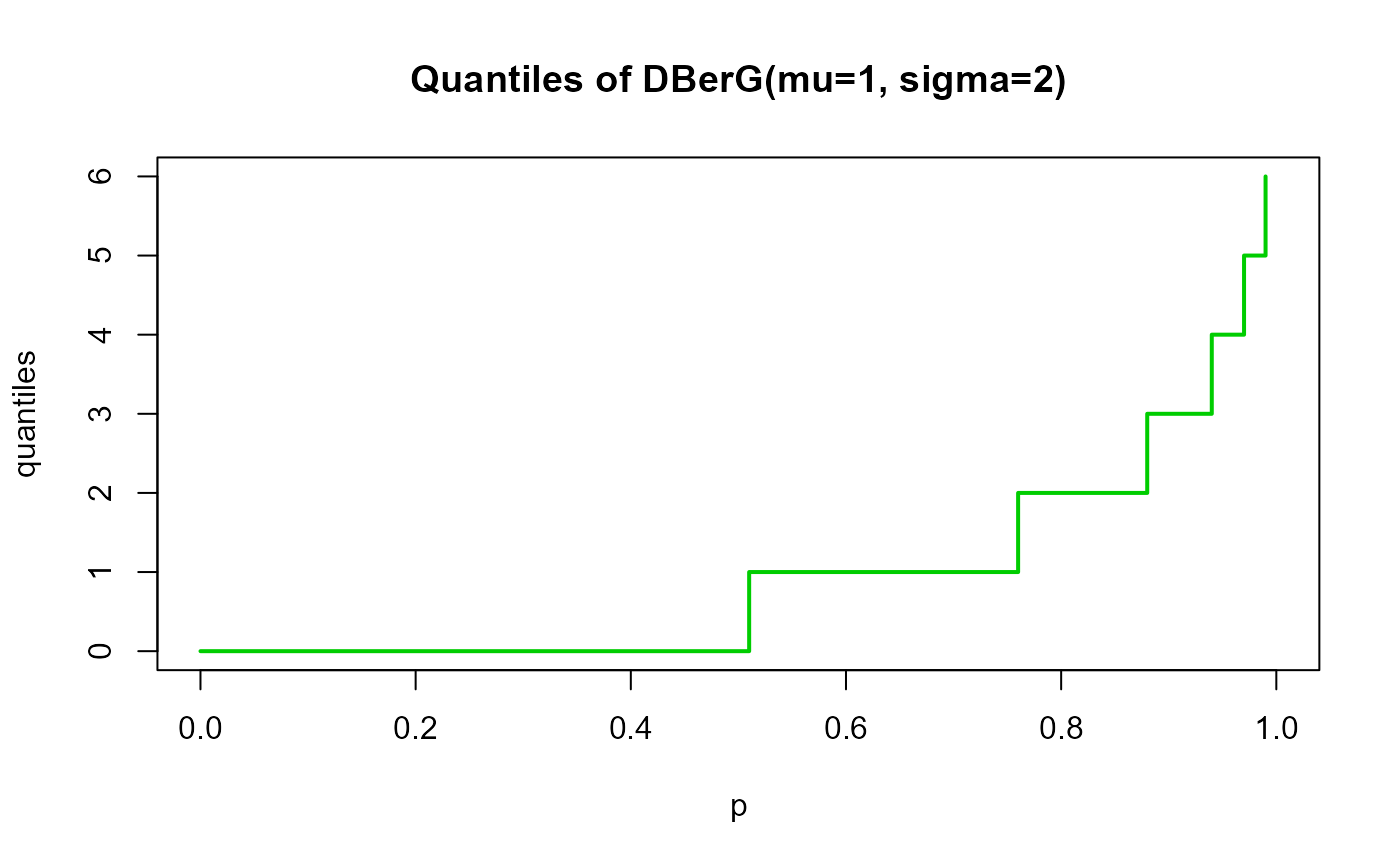These functions define the density, distribution function, quantile function and random generation for the Bernoulli-geometric distribution with parameters \(\mu\) and \(\sigma\).
dBerG(x, mu, sigma, log = FALSE)
pBerG(q, mu, sigma, lower.tail = TRUE, log.p = FALSE)
rBerG(n, mu, sigma)
qBerG(p, mu, sigma, lower.tail = TRUE, log.p = FALSE)Arguments
- x, q
vector of (non-negative integer) quantiles.
- mu
vector of the mu parameter.
- sigma
vector of the sigma parameter.
- log, log.p
logical; if TRUE, probabilities p are given as log(p).
- lower.tail
logical; if TRUE (default), probabilities are \(P[X <= x]\), otherwise, \(P[X > x]\).
- n
number of random values to return.
- p
vector of probabilities.
Value
dBerG gives the density, pBerG gives the distribution
function, qBerG gives the quantile function, rBerG
generates random deviates.
Details
The BerG distribution with parameters \(\mu\) and \(\sigma\) has a support 0, 1, 2, ... and mass function given by
\(f(x | \mu, \sigma) = \frac{(1-\mu+\sigma)}{(1+\mu+\sigma)}\) if \(x=0\),
\(f(x | \mu, \sigma) = 4 \mu \frac{(\mu+\sigma-1)^{x-1}}{(\mu+\sigma+1)^{x+1}}\) if \(x=1, 2, ...\),
with \(\mu > 0\), \(\sigma > 0\) and \(\sigma>|\mu-1|\).
References
Bourguignon, M., & de Medeiros, R. M. (2022). A simple and useful regression model for fitting count data. Test, 31(3), 790-827.
See also
BerG.
Examples
# Example 1
# Plotting the mass function for different parameter values
x_max <- 20
probs1 <- dBerG(x=0:x_max, mu=0.7, sigma=0.5)
probs2 <- dBerG(x=0:x_max, mu=0.3, sigma=1)
probs3 <- dBerG(x=0:x_max, mu=2, sigma=3)
# To plot the first k values
plot(x=0:x_max, y=probs1, type="o", lwd=2, col="dodgerblue", las=1,
ylab="P(X=x)", xlab="X", main="Probability for BerG",
ylim=c(0, 0.80))
points(x=0:x_max, y=probs2, type="o", lwd=2, col="tomato")
points(x=0:x_max, y=probs3, type="o", lwd=2, col="green4")
legend("topright", col=c("dodgerblue", "tomato", "green4"), lwd=3,
legend=c("mu=0.7, sigma=0.5",
"mu=0.3, sigma=1",
"mu=2, sigma=3"))
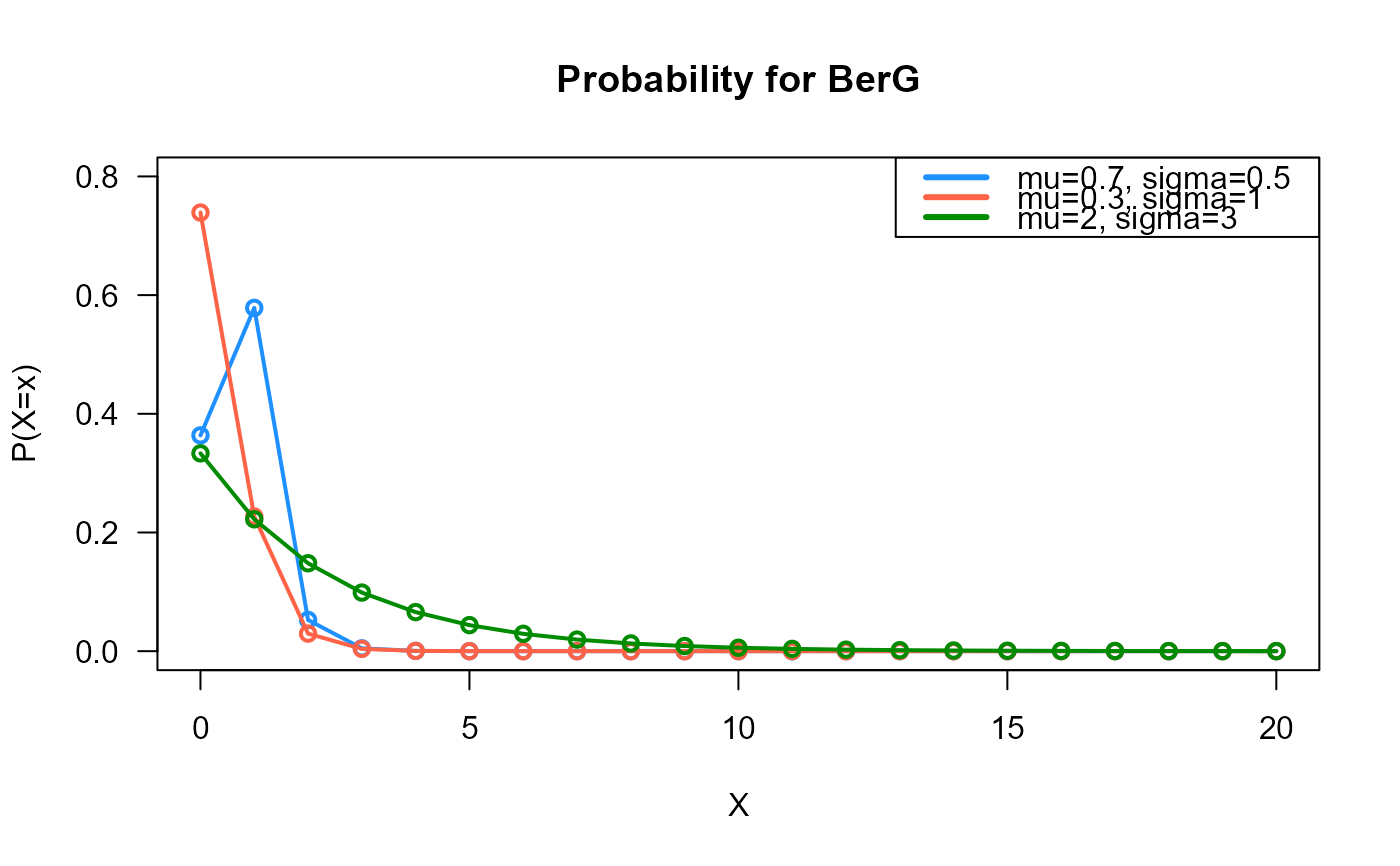 # Example 2
# Checking if the cumulative curves converge to 1
#plot1
x_max <- 10
plot_discrete_cdf(x=0:x_max,
fx=dBerG(x=0:x_max, mu=1, sigma=2),
col="dodgerblue",
main="CDF for BerG",
lwd=3)
legend("bottomright", legend="mu=1, sigma=2",
col="dodgerblue", lty=1, lwd=2, cex=0.8)
# Example 2
# Checking if the cumulative curves converge to 1
#plot1
x_max <- 10
plot_discrete_cdf(x=0:x_max,
fx=dBerG(x=0:x_max, mu=1, sigma=2),
col="dodgerblue",
main="CDF for BerG",
lwd=3)
legend("bottomright", legend="mu=1, sigma=2",
col="dodgerblue", lty=1, lwd=2, cex=0.8)
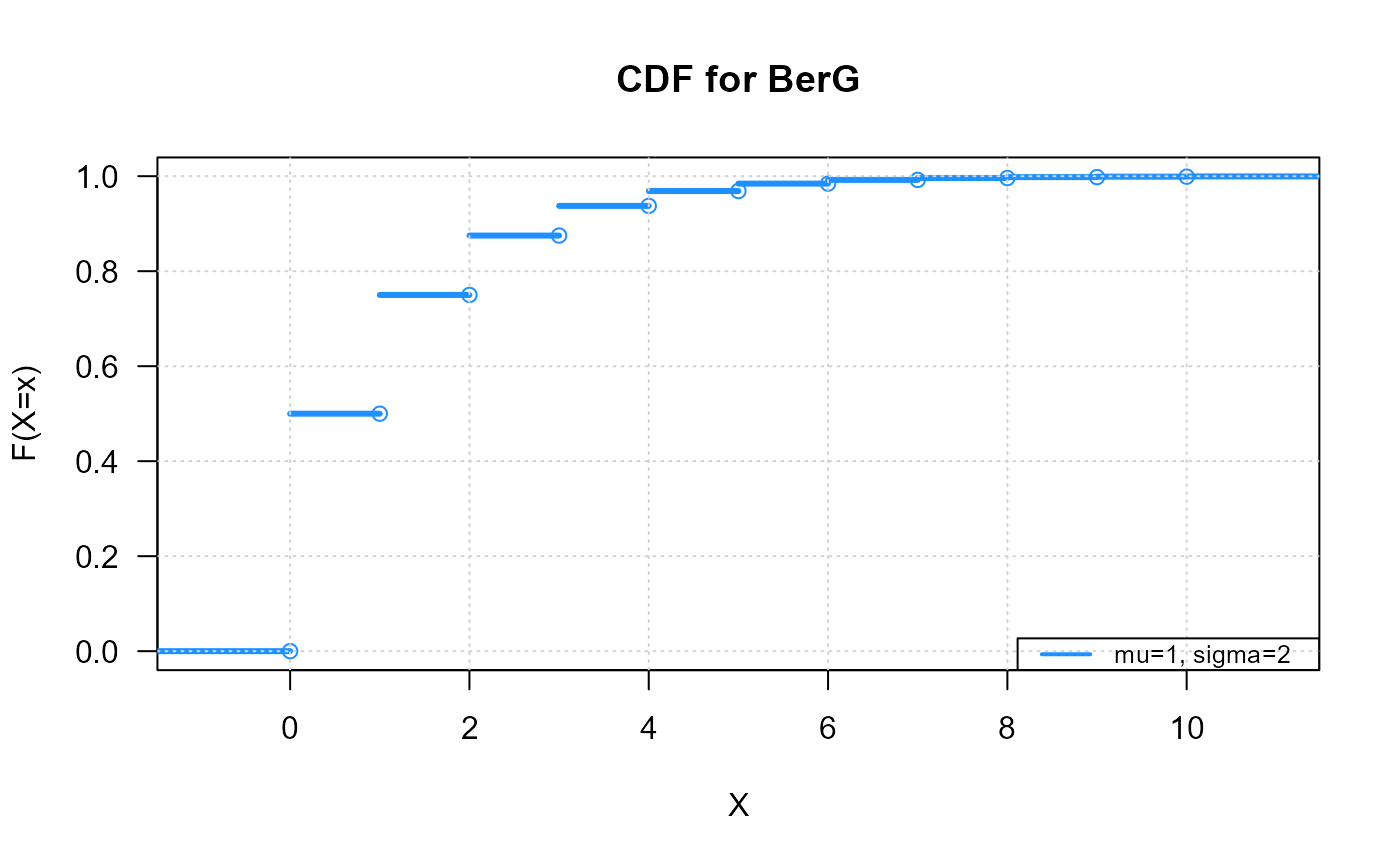 #plot2
plot_discrete_cdf(x=0:x_max,
fx=dBerG(x=0:x_max, mu=3, sigma=3),
col="tomato",
main="CDF for BerG",
lwd=3)
legend("bottomright", legend="mu=3, sigma=3",
col="tomato", lty=1, lwd=2, cex=0.8)
#plot2
plot_discrete_cdf(x=0:x_max,
fx=dBerG(x=0:x_max, mu=3, sigma=3),
col="tomato",
main="CDF for BerG",
lwd=3)
legend("bottomright", legend="mu=3, sigma=3",
col="tomato", lty=1, lwd=2, cex=0.8)
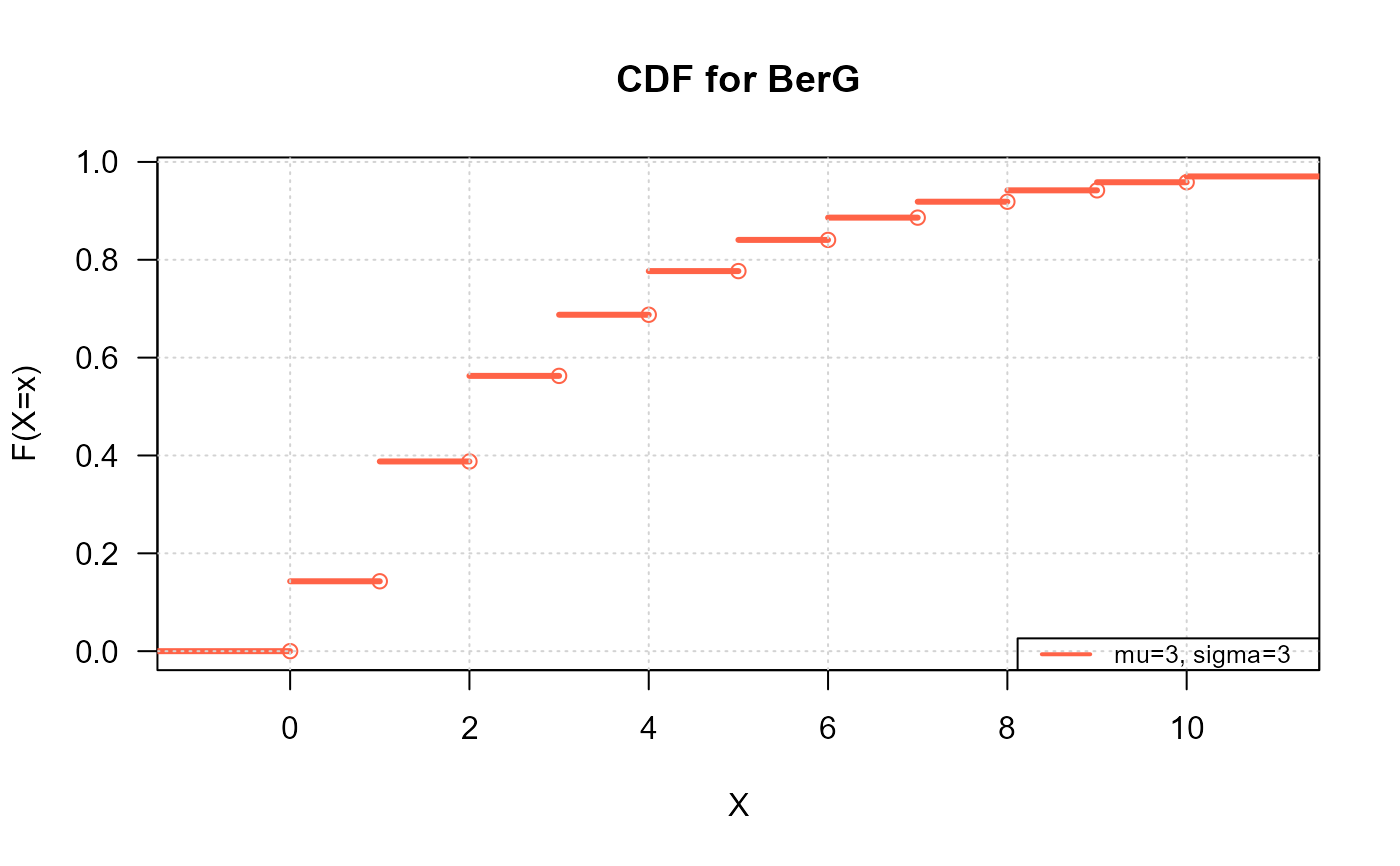 #plot3
plot_discrete_cdf(x=0:x_max,
fx=dBerG(x=0:x_max, mu=5, sigma=5),
col="green4",
main="CDF for BerG",
lwd=3)
legend("bottomright", legend="mu=5, sigma=5",
col="green4", lty=1, lwd=2, cex=0.8)
#plot3
plot_discrete_cdf(x=0:x_max,
fx=dBerG(x=0:x_max, mu=5, sigma=5),
col="green4",
main="CDF for BerG",
lwd=3)
legend("bottomright", legend="mu=5, sigma=5",
col="green4", lty=1, lwd=2, cex=0.8)
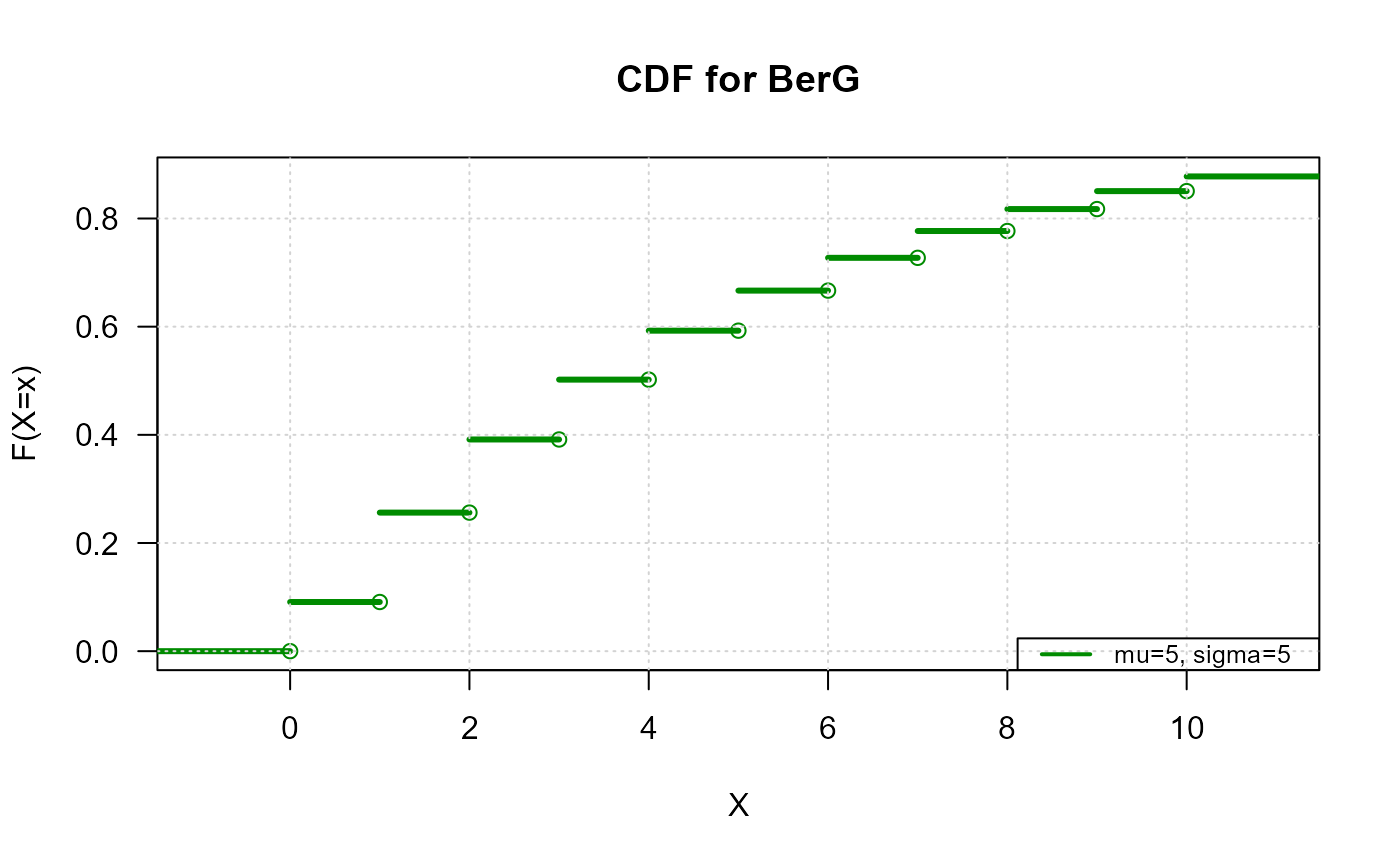 # Example 3
# Comparing the random generator output with
# the theoretical probabilities
x_max <- 15
probs1 <- dBerG(x=0:x_max, mu=0.5, sigma=5)
names(probs1) <- 0:x_max
x <- rBerG(n=1000, mu=0.5, sigma=5)
probs2 <- prop.table(table(x))
cn <- union(names(probs1), names(probs2))
height <- rbind(probs1[cn], probs2[cn])
mp <- barplot(height, beside=TRUE, names.arg=cn,
col=c("dodgerblue3","firebrick3"), las=1,
xlab="X", ylab="Proportion")
legend("topright",
legend=c("Theoretical", "Simulated"),
bty="n", lwd=3,
col=c("dodgerblue3","firebrick3"), lty=1)
# Example 3
# Comparing the random generator output with
# the theoretical probabilities
x_max <- 15
probs1 <- dBerG(x=0:x_max, mu=0.5, sigma=5)
names(probs1) <- 0:x_max
x <- rBerG(n=1000, mu=0.5, sigma=5)
probs2 <- prop.table(table(x))
cn <- union(names(probs1), names(probs2))
height <- rbind(probs1[cn], probs2[cn])
mp <- barplot(height, beside=TRUE, names.arg=cn,
col=c("dodgerblue3","firebrick3"), las=1,
xlab="X", ylab="Proportion")
legend("topright",
legend=c("Theoretical", "Simulated"),
bty="n", lwd=3,
col=c("dodgerblue3","firebrick3"), lty=1)
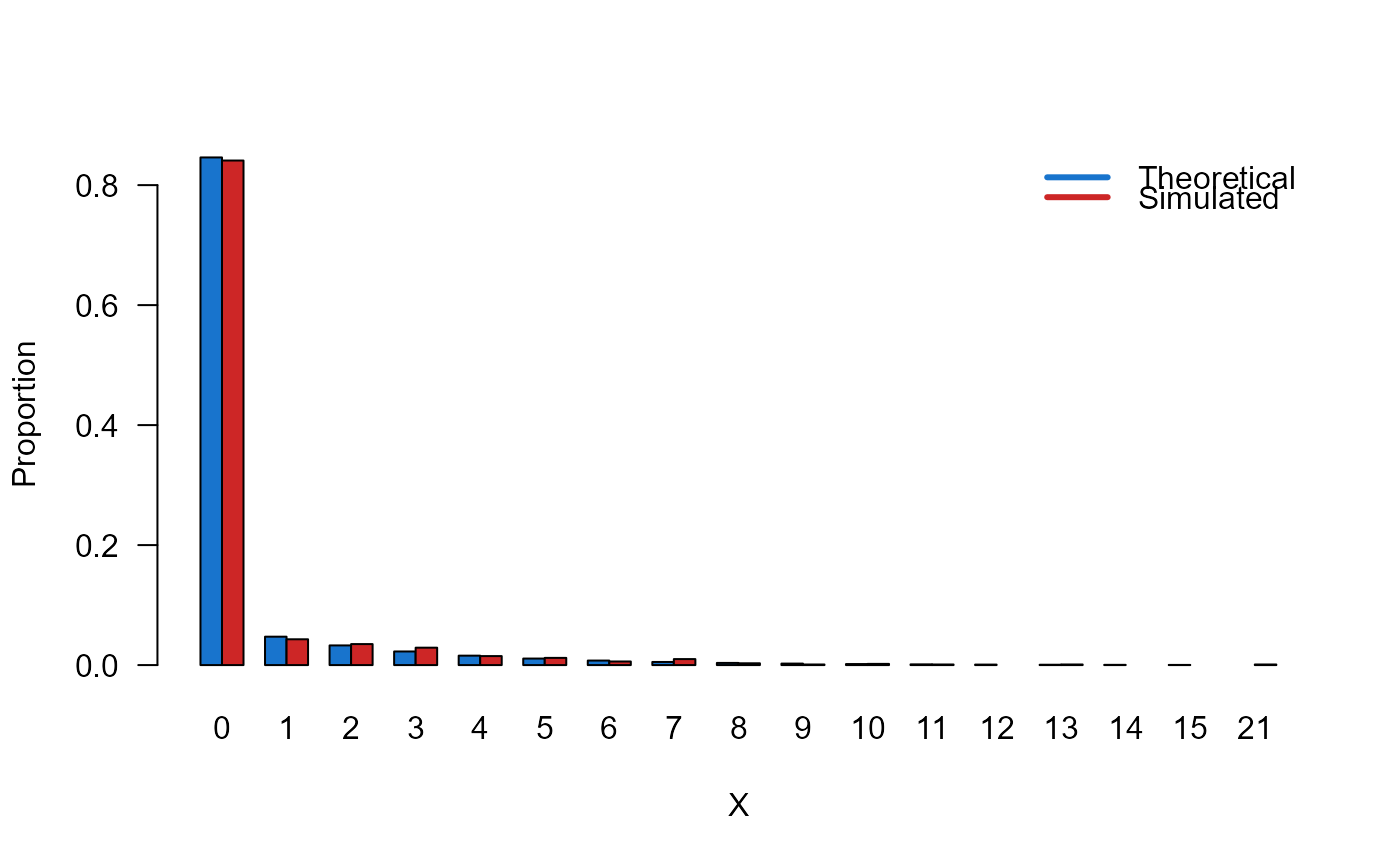 # Example 4
# Checking the quantile function
mu <- 1
sigma <- 2
p <- seq(from=0, to=1, by=0.01)
qxx <- qBerG(p=p, mu=mu, sigma=sigma, lower.tail=TRUE, log.p=FALSE)
plot(p, qxx, type="s", lwd=2, col="green3", ylab="quantiles",
main="Quantiles of DBerG(mu=1, sigma=2)")
# Example 4
# Checking the quantile function
mu <- 1
sigma <- 2
p <- seq(from=0, to=1, by=0.01)
qxx <- qBerG(p=p, mu=mu, sigma=sigma, lower.tail=TRUE, log.p=FALSE)
plot(p, qxx, type="s", lwd=2, col="green3", ylab="quantiles",
main="Quantiles of DBerG(mu=1, sigma=2)")
